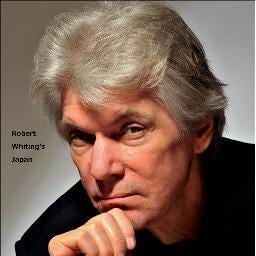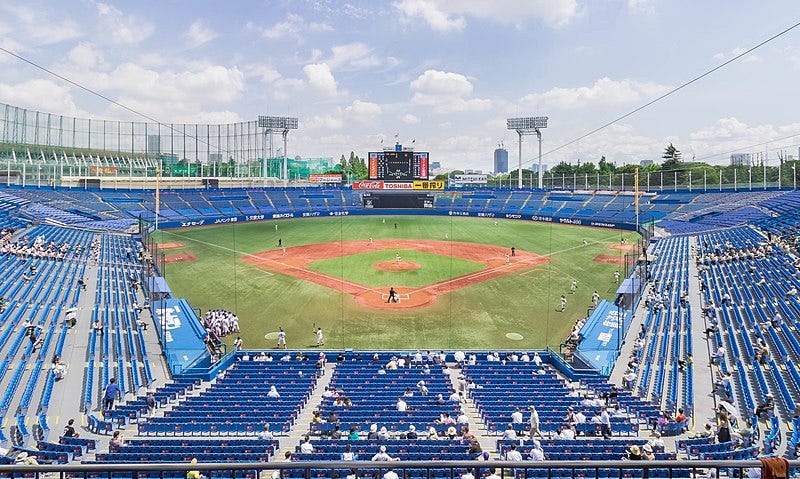TOYKO — The following is an English version of an open letter I recently sent in Japanese on Twitter to Tokyo Governor Koike and other parties involved in the redevelopment of Meiji Jingu Stadium and the surrounding area. Attached is a petition for fans opposing the project to sign.
To: Governor Yuriko Koike, Mitsui Fudosan, Itochu, Tokyo Yakult Swallows, Six Universities League, High School Baseball League, Japan National Baseball Association, Minato Ward Mayor, Shinjuku Ward Mayor
From: Robert Whiting, on behalf of citizens of Tokyo against the planned redevelopment of Meiji Jingu Kyujo
Meiji Jingu Baseball Stadium (Jingu Stadium) is home to the Tokyo Yakult Swallows and other professional baseball teams and has been loved by many baseball fans as the “Mecca of college baseball” featuring teams from the Big Six Universities League.
Jingu Stadium, which opened in 1926, has been the center of Japanese baseball history along with Hanshin Koshien Stadium. It is one of the only remaining baseball stadiums where Babe Ruth played, making it a notable place in the history of world baseball. This stadium is filled with nearly 100 years of tradition and the memories of the players and spectators who played and cheered there under the big blue sky.
However, Jingu Stadium is about to be torn down and replaced with a new stadium as part of the Jingu Gaien redevelopment project. In many ways, this plan is a betrayal of the expectations of baseball fans, and in addition, it threatens to destroy the surrounding environment, including endangering the ginkgo trees that are the symbol of Jingu Gaien.
The following is a list of problems with the current redevelopment plan:
(1) The new stadium will be surrounded by a forest of skyscrapers. The baseball environment will be worsened.
According to the redevelopment plan, three skyscrapers of 190 meters, 185 meters, and 80 meters will be built around the new stadium. Attached to the stadium itself will be a 60-meter-high hotel building. Surrounding the field with tall buildings will deprive fans of the spectacular big sky, sunsets and full moons that they have come to love as part of the Jingu Gaien experience.
In addition, the buildings will create strong winds that will blow onto the stadium, likely impacting the games played there. Spectators will find themselves sitting in the long shadows created by the skyscrapers, which will be uncomfortable and make it difficult for them to enjoy the game. In addition, based on the information shared so far about the plans, the hotel building will be placed behind the infield stands in a design that may force the outfield stands to be compressed. If the outfield stands were to shrink, it would take away half the fun of attending a game at Jingu Stadium given the great popularity of the Yakult Swallows oendan. This could cause people to lose interest in attending games at Jingu Stadium. We ask that further detailed information about the new stadium plans in this regard be released.
2) Jingu No. 2 Stadium and the softball fields will be eliminated. Thus, the general public will no longer be able to play baseball at Jingu Gaien.
Jingu Gaien isn’t only a place for professional baseball. It is also a sacred place for amateur baseball. The Jingu No. 2 Stadium, which has served as the venue for amateur baseball, will also be demolished as part of the redevelopment plan. The six softball fields (located in the plaza in front of the Meiji Memorial Picture Gallery) and the adjacent indoor ball practice building and batting center will also be closed. No replacement facilities will be provided for any of them. The futsal court and golf practice range will also be eliminated.
In promoting Tokyo as an Olympics host, the Tokyo Metropolitan Government proclaimed that Jingu Gaien would be a “sports cluster” where “opportunities will be created for everyone to enjoy sports.” But in reality, the plan is to build non-sports commercial facilities and courts for an expensive members-only tennis club and steal sports facilities from the public. Shutting out amateur athletes and the general public makes a mockery of the spirit of the founding of Jingu Gaien.
The beloved tradition of Swallows players practicing on the open field in front of the Picture Gallery will also be lost. The redevelopment plan, as a whole, will alienate the general public from the game of baseball.
(3) Destruction of an important architectural heritage
Jingu Stadium, which was built as part of the construction of Jingu Gaien, was designed by Masakazu Kobayashi, who also designed the nearby Meiji Memorial Picture Gallery. The Picture Gallery is designated as a national important cultural property. Jingu Stadium, including its beautiful arched colonnade arcade, is also architecturally important and should be considered a valuable historical cultural asset. The window frames of the stadium’s colonnade have the same design as those of the Picture Gallery. Why should we stand idly by and let such a historical cultural asset be lost because of commercial priorities?
(4) The symbol of Jingu Gaien, the rows of ginkgo trees, will be damaged.
The construction of the new stadium will destroy the stadium’s harmony with Jingu Gaien. The deep pillars that will be driven into the ground for construction of the new stadium’s outfield fence only 6 meters away from the ginkgo trees will damage their roots, cut off the supply of water, and inhibit their growth. Just picture in your mind the row of dead gingko trees after they have withered as a result of the damage from the stadium construction. How proud will we baseball fans be able to feel about attending games at this new stadium knowing that it will kill these iconic and beloved trees?
Furthermore, the smaller row of 18 ginkgo trees at the east entrance of the Chichibunomiya Rugby Stadium are in the way of the new stadium, and so plans are for them to be transplanted. However, tree experts warn that the likelihood of such huge trees being able to be transplanted successfully is low, so they will most likely die as well.
Thus, the construction of the new stadium will lead to the destruction of precious 100-year-old trees.
(5) Huge amounts of CO2 and construction waste will be generated by building a new stadium.
Beautiful Hanshin Koshien Stadium, built at about the same time as Jingu Stadium, was renovated during the offseason, giving it a new lease on life. In Boston and Chicago, stadiums older than Jingu Stadium, Fenway Park and Wrigley Field, have been restored and are beloved symbols of their cities.
In this era of environmental crisis, Jingu Stadium should be renovated, not relocated and rebuilt. For the Tokyo Metropolitan Government, which claims to be pursuing a “Green Transformation,” renovation should be the best way forward.
The plan to relocate Jingu Stadium is fraught with problems. However, it is being pushed though without baseball fans being informed of the details and without any consideration of reforming the current structure instead. Jingu Gaien, this beautiful place filled with green, has been passed down over generations and has a special place in the hearts of baseball fans. We who love Jingu Stadium strongly oppose this redevelopment plan that shuts the general public out of sports.
Governor Koike and the developers, on behalf of fellow baseball fans, I call on you to halt the Jingu Gaien Redevelopment Plan and renovate our beloved Jingu Stadium so it can be continued to be used going forward.
Robert Whiting
Those who wish to sign the following petition to halt the Jingu Gaien Redevelopment Plan can click on the link below. Use the English-Japanese conversion mode on your computer if necessary.






頑張って Hope you can hit a home run on this issue.
Great article. I was looking forward to going to a new stadium, but didn’t know the drawbacks.